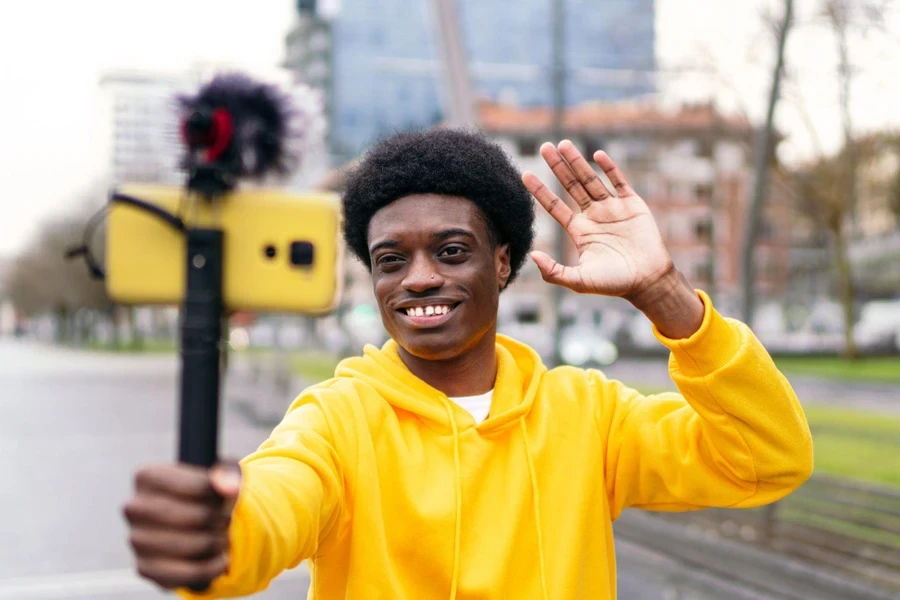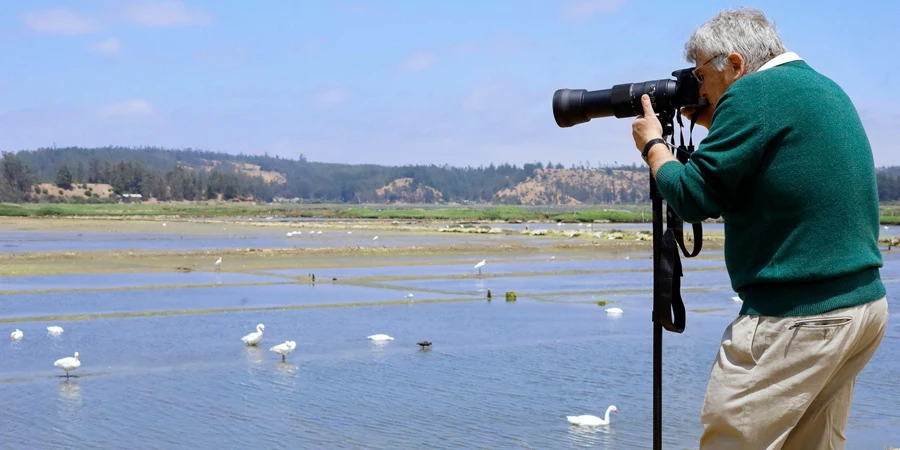Monopods have emerged as an indispensable tool in the arsenal of modern photography, offering unmatched stability and flexibility for capturing crisp images under various conditions. These single-legged supports are especially favored for their lightweight design and ease of maneuverability, enabling photographers to execute quick setups and adjustments in the field. Ideal for sports, wildlife, and event photography, monopods help in achieving steady shots without the bulk of a tripod, significantly enhancing the photographic results. As the demand for high-quality imaging solutions continues to rise, understanding the nuanced benefits of these tools becomes crucial for those investing in photography equipment.
Table of Contents
1. Exploring monopod varieties and their photographic impact
2. Current monopod market dynamics
3. Selecting the perfect monopod: Factors to consider
4. Highlighting 2024’s top monopod models
Exploring monopod varieties and their photographic impact

Monopods serve as a cornerstone in the realm of photography, blending the agility of handheld shooting with the stability akin to that of tripods. This unique balance makes monopods indispensable in scenarios where mobility and rapid setup are crucial, such as in sports and wildlife photography.
Cataloging monopod types: Monopods range from straightforward designs to advanced configurations equipped with features like fluid heads and quick release systems. Basic monopods, often lightweight and simple, offer fundamental support and are suitable for environments where speed is of the essence. Meanwhile, fluid head monopods provide smoother transitions and are preferred in video production for their ability to pan and tilt effortlessly. Sophisticated models, like the IFOOTAGE Cobra 3, introduce innovations such as pedal systems that enhance stability and adaptability, making them ideal for professional videographers who demand versatility and quick adjustments.
Monopods at work: The functionality of monopods extends across various photography scenarios, each benefiting distinctly from the monopod’s attributes. In dynamic shooting environments, such as sporting events or wildlife habitats, the quick height adjustments and lightweight nature of models like the GEEHOPE D370C facilitate swift movement and repositioning. This adaptability is crucial for capturing fleeting moments in fast-paced settings.
Travel photographers benefit significantly from models like the Leofoto Travel Monopod, which combines portability with robust construction. Its extended height range allows for shooting over obstacles or from elevated positions, providing versatility without the bulk of traditional tripods.
For hobbyists or emerging professionals, affordability and functionality are key. The Altura Photo 62-Inch Monopod strikes a balance between cost and performance, offering a reliable support system that’s easy to manage and deploy. Its universal thread mount ensures compatibility with a wide range of cameras, making it a practical choice for those still exploring different facets of photography.
In each instance, the choice of monopod impacts the photographic outcome by either enabling a higher degree of maneuverability or enhancing the image’s stability. As the market continues to evolve, the introduction of advanced features in monopods is likely to further enrich the photography experience, catering to an even broader array of needs and scenarios.
Current monopod market dynamics

Experts currently value the tripods and monopods market at US$ 1.21 billion, and they expect it to reach US $1.72 billion by 2032. They estimate this boost will happen at a 3.45% compound annual growth rate (CAGR) from 2024 to 2032.
Innovation in monopod technology: Recent advancements in monopod technology have significantly elevated their functionality, appealing to a broader range of photography professionals. Innovations such as the integration of fluid heads, which allow for smooth panning and tilting, and carbon fiber builds for lightweight durability, have transformed how monopods are used in the field. The introduction of quick-release systems and multi-functional designs, which combine the features of monopods, extension rods, and mini tripods, cater to a variety of shooting scenarios, enhancing versatility without compromising stability.
For instance, models like the IFOOTAGE Cobra 3 feature a unique pedal locking system, which simplifies adjustments and enhances user efficiency by allowing quick positional changes without the need to manually readjust the setup. This type of innovation not only supports the photographer’s workflow but also expands the utility of monopods into areas like video production where time and flexibility are crucial.
Trends shaping monopod demand: The demand for monopods is influenced by several key trends within the photography industry. First, the rise in popularity of adventure and travel photography, where the need for compact, lightweight equipment that can be easily transported over diverse terrain is critical, has spurred interest in highly portable monopod models. Secondly, the expansion of content creation across platforms such as YouTube and Instagram creates a continuous demand for video-compatible gear, further pushing the development of monopods that can support dynamic shooting needs.
Consumer preferences are increasingly leaning towards high-quality, versatile photography solutions that offer stability and flexibility without the bulk associated with traditional tripods. As a result, the market is seeing a growing preference for products like the SIRUI P-424FS, which offers a high weight capacity and multifunctionality to support a range of cameras and accessories.
The market for monopods is expected to continue growing as innovations enhance their applicability and as consumer behaviors shift towards more mobile and flexible photography setups. This trend is supported by projections from market analysis, which predict a steady increase in the adoption of advanced monopod systems across both amateur and professional photography sectors. Such insights indicate that the monopod market will remain vibrant, with continual innovations and a broadening user base driven by evolving photography styles and the increasing demand for high-quality visual content.
Selecting the perfect monopod: Factors to consider

Balancing stability and load: Selecting the right monopod requires a nuanced understanding of the balance between stability and load capacity, which is influenced by the specifications of the camera and lenses used. Stability is a paramount consideration, especially for professional photographers who employ heavy lenses and shoot under dynamic conditions where even minor tremors can compromise image quality. Monopods such as the Gitzo Series 4 are renowned for their robust construction, capable of supporting heavy equipment while maintaining ease of mobility. This model, for example, can support up to 30 pounds, ideal for professional DSLR cameras with extended lenses, offering the rigidity needed for sharp images without the weight typically associated with such stability.
Material matters: Weight vs. Durability. The choice between carbon fiber and aluminum is central to selecting a monopod, as each material offers distinct benefits and trade-offs concerning weight and durability. Carbon fiber, known for its strength-to-weight ratio, is lighter than aluminum and dampens vibrations better, making it a preferred choice among professionals who often travel and shoot in varied environmental conditions. For instance, the Benro SupaDupa Pro MSDPL46C is a carbon fiber monopod that weighs only a few pounds yet can extend over 60 inches and retract to less than 20 inches, making it incredibly portable without sacrificing strength.
Aluminum, on the other hand, provides a more cost-effective option and is favored for its high durability and lower price point. Although heavier, aluminum monopods like the Manfrotto 290 Xtra Aluminum Monopod offer great stability and can endure the rigors of extended use in harsh environments. They are ideal for scenarios where the monopod will be subject to significant wear and tear.
Optimizing for height and portability: The practicality of a monopod in real-world scenarios is greatly affected by its height range and portability. Optimal height adjustment capabilities are crucial for adapting to various shooting contexts, from low-angle macro photography to elevated views over a crowd. The 3 Legged Thing Trent 2.0, for example, extends to over two meters, providing ample height for most photographic needs while collapsing down to a manageable size for transport.
Portability is especially important for field photographers who need to move quickly and often. Lightweight monopods with telescopic features offer the best mobility without compromising on stability. The iFootage Cobra 3, renowned for its quick extension mechanism and compact design, allows photographers to set up and adjust their shots swiftly, a crucial factor in fast-paced environments like sports or wildlife photography.
Highlighting 2024’s top monopod models

Showcasing innovative design: The monopod market in 2024 features several standout models that epitomize cutting-edge design and functionality. Among these, the Gitzo Series 4 Monopod exemplifies innovation with its Carbon eXact tubes and G-Lock Ultra mechanism. This design provides unparalleled rigidity and quick extension capabilities, allowing photographers to adjust the monopod swiftly to desired heights, which can be crucial during dynamic shooting situations. This model is particularly favored by wildlife and sports photographers for its reliability and ease of use in the field.
Another remarkable model is the Benro MSDPL46C SupaDupa Carbon Fiber Monopod, which incorporates a unique rotating foot that allows for smooth panning and leveling. This feature is ideal for videographers who need to make quick, smooth pans without adjusting the entire setup. The monopod’s carbon fiber build ensures it remains lightweight yet capable of supporting heavy camera rigs, making it a top choice for professionals who require both portability and robust support.
Budget and premium picks: For those on a budget, the Manfrotto Element MII offers exceptional value. It is crafted from durable aluminum and can extend up to 62.59 inches while maintaining a compact fold-down size for easy transport. Despite its lower price, this model supports a considerable weight limit of 33 pounds, accommodating a wide range of cameras and lenses.
On the premium end, the Sirui P-204SR Professional Camera Monopod stands out for its versatility and high-quality build. It features a stable base that can be deployed quickly and a unique design that allows it to convert into a tabletop tripod. This monopod offers a height range from 26.8 to 63 inches and supports up to 17.6 pounds, making it suitable for both photography and videography.
For those seeking the ultimate in monopod technology, the Manfrotto MVMXPROC5 Carbon Fiber Monopod represents the pinnacle of the market. This model is not only crafted from high-grade carbon fiber for maximum durability and lightness but also features a fluid head for seamless video shooting and a very high maximum height of 74.02 inches, making it ideal for users who need the best in class for both features and functionality.
Conclusion
The right monopod can significantly elevate the quality and versatility of photography in 2024, offering professionals enhanced stability, flexibility, and portability. With advancements in design and materials, such as the incorporation of carbon fiber and innovative quick-adjust mechanisms, today’s monopods not only support a broad range of photographic equipment but also adapt seamlessly to dynamic shooting environments. Whether capturing wildlife, sports, or cinematic video, the thoughtful selection of a monopod aligns with the evolving needs of photographers, ensuring that every shot is as sharp and steady as possible.




